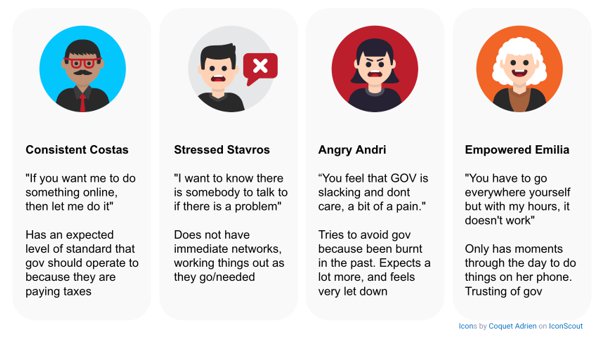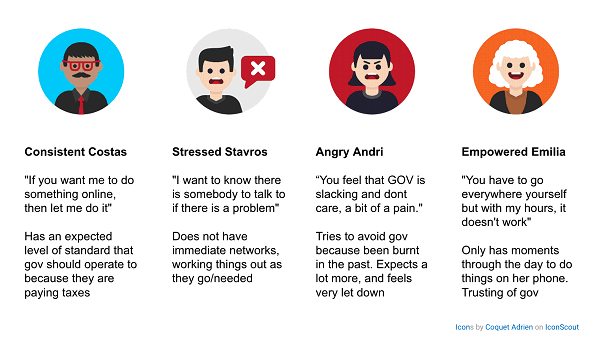 "It is citizen-centric, that is, our concern is when we give a service to the citizen that it is simple, understandable and designed together with the citizen. From day one, we've been calling in citizens and involving them in it so we know that what we're going to deliver is what citizens want."
-Deputy Minister Kokkinos
When you interact with the Government, honestly, how do you feel?
"It is citizen-centric, that is, our concern is when we give a service to the citizen that it is simple, understandable and designed together with the citizen. From day one, we've been calling in citizens and involving them in it so we know that what we're going to deliver is what citizens want."
-Deputy Minister Kokkinos
When you interact with the Government, honestly, how do you feel?
Do you expect things to work more easily as you are a tax paying citizen?
Do you get frustrated when you are asked to give the same details time and time again?
Do you get stressed, double guessing if you’ve made any mistakes in your paperwork? or,
Do you question how you are possibly going to visit the Citizen Service Centre when you are working such long hours?
Well you are certainly not alone.
The Digital Services Factory (DSF) team did some qualitative user research to answer the question ‘What is the sentiment towards the Cypriot Government?’.
Why is the DSF team interested in this at all?
The DSF team is working to digitally transform Cypriot Government services by using User Centred Design methods.
User Centred Design is a methodology used to create digital services where users are at the heart of the services we design. It's important to really understand who the users are to make sure your users’ needs are truly being met.
And so, the DSF team set out to understand who the users of Government services are and what their perceptions are towards the Government generally.
The DSF team did qualitative user research speaking to 16 Greek Cypriots. Participants were asked to describe their current interactions with the Government, good and bad experiences, and explain the factors that impact their levels of trust and confidence with Government interactions.
We found clear overlapping patterns in how the participants think, feel and behave.
What were the results? Four user typologies!
What are Typologies you ask? Typologies can be described as a user archetype, or a type of user. Good typologies are formed through qualitative research with real users and described as someone the team can get to know and create good services for. Teams can use typologies to help make decisions about the service and how it is designed
Enough chit chat, let’s meet our four typologies
Our research found these four typologies: Consistent Costas, Stressed Stavros, Angry Andri and Empowered Emilia.
Let’s get to know them a bit better...
Consistent Costas:
He doesn’t expect greatness, just something that works. He’s indifferent about the Government, but has expectations for how it should operate given he is paying taxes. He uses the internet for everything in his life, and so it’s a nuisance when the Government services cannot also be used in the same way. Costas is a type of person who wants things to be user friendly, clear and simple so he can do what he needs to do.
Stresses Stavros:
Stavros is scared of doing the wrong thing and is the type of person who needs to interact with help staff often to make sure he is not making any mistakes. He gets worried that once again he’ll miss out on entitlements because he didn’t provide one document that wasn’t clearly marked as needed. To avoid getting stressed, he needs frequent reassurance of timeframes, requirements, processes and status updates.
Angry Andri:
Andri does not trust the government because she has been burnt in the past and feels very let down. She feels that the Government should be accountable for the services they provide, or in her case, services that aren’t provided (eg. not answering calls, not helping people complete tasks). She gets more frustrated when she needs to do extra work giving the Government information that she believes they already have. All this dismay means she tries to avoid Government interactions at all costs.
Empowered Emilia:
She trusts the Government but is very busy and doesn’t have the time to wait in queues or have back and forth phone calls. She values flexibility, to do things online quickly and in her own time. She just needs to be enabled to do so. She prefers zero human interaction because it slows her down, and doesn’t want to waste time reading documents and filling out unnecessary forms. She just wants clear instructions so she can do what is needed easily.
The DSF team takes into consideration the needs of these four typologies when designing any Government service. Knowing that services must equally work for Stressed Stavros as for Empowered Emilia helps the team to make effective decisions and be confident that users' needs are at the centre of the design.
Overtime, it’s normal that people’s sentiment of government changes, and so our four typologies may also change. The DSF team will continue to re-visit and iterate the typologies with ongoing user research.
Now you’ve had a closer look, which typology are you?